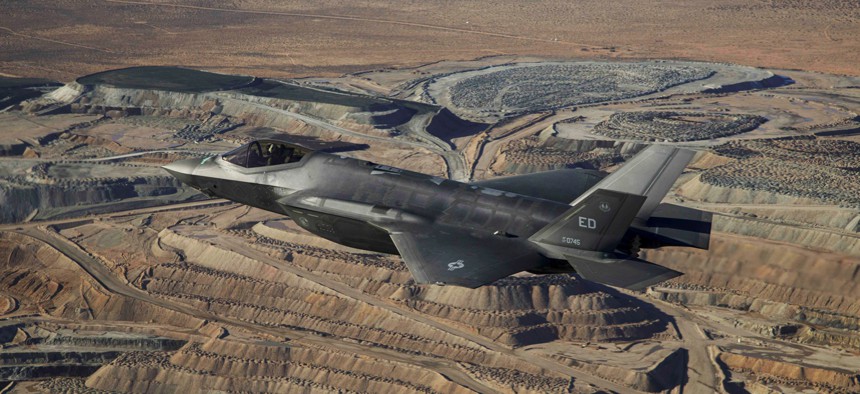
An F-35A in flight above the Mojave Desert in California, on January 6, 2023. F-35 Joint Program Office
Air Force frets as Lockheed announced another delay for new-tech F-35
The first F-35 with a new tech package might not arrive until June, Lockheed now says.
This story was updated at 6:09 p.m.
The newest version of the F-35 won’t be delivered until at least April—possibly even June—due to hardware and software problems, builder Lockheed Martin said in a public filing released today.
Lockheed also said the company expects to deliver 97 aircraft in 2023, down from its previously reduced estimate of 100 to 120 jets.
All of the jets will be in the TR-2 configuration; Lockheed had previously expected to deliver the first TR-3-equipped F-35 by December. Short for Technology Refresh-3, the TR-3 jets will have additional computing power needed for Block 4 improvements to sensors and weapons. But the TR-3 jets have been delayed by software and other developmental problems.
“The development of the Integrated Core Processor by L3Harris drove initial delays due to unexpected challenges associated with hardware and software development, component and system integration testing and system qualification testing. The hardware development challenges impacted hardware/software integration, compressing the software testing schedule,” Lockheed said in a Wednesday statement.
L3Harris said in a statement that the company "overcame some early design challenges and delivered a fully qualifiable Integrated Core Processor to Lockheed Martin well over a year ago. In June 2022, L3Harris began delivering flight test hardware after completing Safety of Flight qualification testing. We continue to work closely with Lockheed Martin to support them in the integration of their software into the TR3 hardware. L3Harris remains fully committed to the F-35 Program, to the U.S. military, and international partners."
Lockheed is required to deliver nine TR-3 aircraft per month, but the Pentagon is refusing to accept the jets until they can pass certain tests. This new delay could force the company to sit on roughly 100 jets.
“The number of 2024 F-35 deliveries will depend on when the first TR-3 aircraft is delivered and the time needed to complete the customer’s acceptance process. We continue to assess impacts to 2024 and will have updates as the test plan continues,” the filing said.
Air Force leaders say the delays are reducing their ability to provide combatant commanders with combat aircraft that can tackle the toughest threats.
“The high-end software, high-end hardware, high-end [electronic warfare] is a hard business,” Gen. Mark Kelly, head of Air Combat Command, said Wednesday during a Defense News conference. “There [are] more nations around the planet that can build a nuclear weapon than can code a core processor to an integrated core processor to mate with that hardware and that electronic warfare.”
The Pentagon and industry need to “lock arms” and work through this as a team, Kelly said Wednesday.
“Getting these jets on time and fielded is absolutely critical to our ability to meet the global demand signal on a day-to-day basis,” Lt. Gen. James Slife, the service’s deputy chief of staff for operations.
Kelly said the delay in deliveries will reduce the service’s ability to meet its demands around the world because Air Combat Command only accounts for units to be benched for a certain amount of time, Kelly said. And if they’re down longer than expected, “we will feel that in our global force management with our combat commands that we send combat power to,” Kelly said.
The Air Force plans to continue to deploy older F-35s and “use what we have” until TR-3 jets show up, Kelly said. However, the new TR-3 software will be needed to face threats, the general added.
“The whole idea of a challenging peer scenario is a very challenging electromagnetic spectrum and very capable threats, and if we're going to engage that spectrum, engage those threats, we've got to have the fastest processing, the best jamming, the most coherent waveforms available and that takes a really, really agile, stable software load to unlock those Block 4 hardware and unlock the EW,” Kelly said. “That's kind of the secret sauce that we're going to need.”
While the Air Force wishes it could evaluate whether a TR-2 or TR-3 jet is needed depending on the crisis that pops up—it doesn’t, Slife said. And the service is strapped for tails as it is, he added.
“It's a knife's edge of capacity that we're dealing with everyday. It's frankly—check your pockets and see what you have in your pocket and that's what goes,” Slife said.




